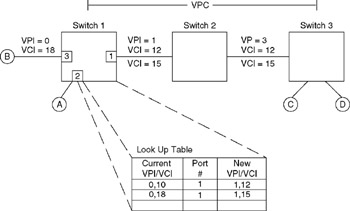2.12 Using Connection Identifiers
2.12 Using Connection Identifiers
To illustrate the use of connection identifiers in cell switching, consider Figure 2.21, which illustrates a three-switch ATM network with four endpoints. When switch 1 receives a cell from device A connected to port 2 with VPI = 0, VCI = 10, it uses the VPI and VCI values to perform a table lookup, assigning VPI = 1, VCI = 12 for the cell header and switching the cell onto port 1. Similarly, when switch 1 receives a cell on port 3 with VPI = 0, VCI = 18, its table lookup operation results in the assignment of VPI = 1, VCI = 15 to the cell's header and the forwarding of the cell onto port 1. If we assume switch 2 is a VP switch, it only reads and modifies the VP; thus, the VCIs are shown exiting the switch with the same values they had upon entering the switch. At switch 3, the VPI is broken down, with virtual channels assigned to route cells to endpoints C and D that were carried in a common virtual path from switch 1 to switch 3.

Figure 2.21: ATM Cell Switching Example
The assignment of VPI and VCI values is an arbitrary process that considers those already in use, with the lookup tables being created when a connection is established through the network. Concerning that connection, it results from an ATM endpoint requesting a connection setup via the user “network interface through the use of a signaling protocol that contains an address within the cell. That address can be in one of three formats. One known as E.164 is the same as that used in public telephone networks, while the other two address formats include domain identifiers that allow address fields to be assigned by different organizations. The actual signaling method is based on the signaling protocol used in ISDN and enables a QoS to be negotiated and agreed to during the connection setup process. The QoS is based on metrics assigned to different traffic classes, permitting an endpoint to establish several virtual connections where each connection transports different types of data with different performance characteristics assigned to each connection. Table 2.10 summarizes the relationship between the five types of specified ATM traffic classes, the ATM Adaption Layer (AAL) that will support each class, the timing relationship between source and destination, and bit rate per traffic class, as well as summarizes seven metrics used to provide a QoS for each traffic class.
| Traffic Classes | |||||
|---|---|---|---|---|---|
| Constant Bit Rate | Variable Bit Rate Real-Time | Available Bit Rate Now Real-Time | Variable Bit Rate | Unspecified Bit Rate | |
| ATM Adaption Layer | AAL 1 | AAL 2 | AAL 3/4, 5 | AAL 3/4 | Unspecified |
| Timing Relationahip Source Destination | |||||
| Bit Rate | |||||
| Traffic Definition Metrics | Specified | Specified | Specified | Specified | Unspecified |
| Cell Loss Ratio | |||||
| Cell Transfer Delay | Maximum Specified | Maximum | Mean Specified | Unspecified | Unspecified |
| Cell Delay Variation | Specified | Specified | Unspecified | Unspecified | Unspecified |
| Peak Cell Rate | Specified | Specified | Specified | Specified | Specified |
| Sustainable Cell Rate | N/A | Specified | Specified | N/A | N/A |
| Minimum Cell Rate | N/A | N/A | N/A | Specified | N/A |
As previously indicated, ATM can be used as a desktop-to-desktop transport mechanism or can function as a backbone to connect existing IEEE 802 networks together and into an ATM infrastructure. Figure 2.21 illustrates an example of desktop-to-desktop or endpoint-to-endpoint ATM operation. In actuality, the cost of ATM adapters, as well as the considerable investment previously made in Ethernet, Token Ring, and FDDI infrastructures , precluded the widespread adoption of ATM to the desktop. However, the scalability of ATM resulted in the growing use of the technology as a backbone for interconnecting older LANs as well as providing for a migration strategy to ATM. Readers are referred to the LAN Emulation section in Chapter 9 for detailed information on how ATM is used as a backbone network.
EAN: 2147483647
Pages: 111